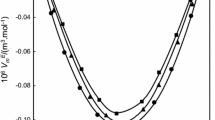Summary
The viscosity-concentration data for thed-, l- anddl-forms of camphor, camphoric acid, sodium camphorate,isonitrosocamphors and camphorquinone have been analysed, and the following conclusions may be drawn:—
-
(1)
The simple mixture rule does not apply as the viscosity-composition graphs are not linear.
-
(2)
The formula of Kendall, involving the cube root of viscosity does not apply to the data given in this paper: the calculated values of the “Viscosity” of the solute are very variable, except in the case of camphorquinone in chloroform.
-
(3)
The logarithmic viscosity formula of Arrhenius gives satisfactory results in all cases except withisonitrosocamphors. The density-composition graph ofisonitrosocamphor departs from linearity, indicating a volume change, and this may account for the non-applicability of the Arrhenius’ formula.
-
(4)
The formula of Arrhenius fits in better with observations, when the concentration is expressed in moles per 1000 g. ofsolvent, rather than moles per 1000 g. or 1000 c.c. ofsolution. There is, however, one exception in camphorquinone, whose chloroform solutions give better agreement with the Arrhenius’ formula when the concentration is expressed as moles per 1000 c.c. of solution. The density-composition graph of these solutions is not linear.
-
(5)
The applicability of the Arrhenius’ formula is also illustrated by plotting logν against molecular concentration, expressed as under (4), when straight lines are obtained.
Similar content being viewed by others
Literatur
Phil. Mag., 1900,49 (5), 274.
Scient. Pap. Bur. Stand., 1917, No. 298.
Trans. Chem. Soc., 1910,97, 1253.
Loc. cit., Trans. Chem. Soc., 1912,101, 552; 1913,103, 25.
Proc. Ind. Acad. Sci., 1937,5, 484.
Macleod,Trans. Farad. Soc., 1925,21, 158.
Proc. Ind. Acad. Sci., 1937,5, 484.
Ann. d. Phys., 1906,19, (4), 289.
Zeit. Physik. Chem., 1887,1, 285.
J. Amer. Chem. Soc., 1917,39, 1790.
The Viscosity of Liquids, London, 1914, p. 44.
Trans. Chem. Soc., 1908,93, 2033.
J. Amer. Chem. Soc., 1917,39, 1802.
Author information
Authors and Affiliations
Rights and permissions
About this article
Cite this article
Singh, B.K. The physical identity of enantiomers. Proc. Indian Acad. Sci. (Math. Sci.) 7, 50–67 (1938). https://doi.org/10.1007/BF03045380
Received:
Issue Date:
DOI: https://doi.org/10.1007/BF03045380




